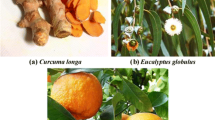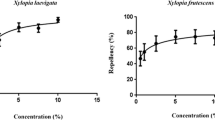Abstract
The essential oil of Cananga odorata flowers was evaluated for oviposition-deterrent, ovicidal, insecticidal, and repellent activities toward three mosquito species: Aedes aegypti, Anopheles dirus, and Culex quinquefasciatus. Oviposition deterrence of the oil was evaluated on gravid females using oviposition deterrence bioassay. The results showed that 10 % Ca. odorata exhibited high percent effective repellency against oviposition at 99.4 % to Ae. aegypti, 97.1 % to An. dirus, and 100 % to Cx. quinquefasciatus. Ca. odorata oil was tested for ovicidal activity. Regression equations revealed that the ovicidal rates were positively correlated with the concentrations of the essential oil. As the concentration of essential oil increased from 1, 5, and up to 10 % concentration, the ovicidal rate increased accordingly. Larvicidal activity of the oils was used on immature stages (third and fourth instar lavae and pupae). The maximum larval mortality was found with 10 % Ca. odorata against immature stages, and there were LC50 values ranged from 10.4 to 10.5 % (for Ae. aegypti), <1 % (for An. dirus), and <1 % (for Cx. quinquefasciatus). Adulticidal properties were evaluated with unfed females. Ten percent Ca. odorata oil had high knockdown rates against the three mosquito species at 96 % (for Ae. aegypti), 98.4 % (for An. dirus), and 100 % (for Cx. quinquefasciatus), with EC50 values of 6.2, 4.7, and 5.4 %, respectively. It gave moderate mortality rates after 24 and 48 h of exposure. Ca. odorata oil was assessed for repellency to females by using the modified K&D module. Ten percent Ca. odorata oil gave the strongest value against Ae. aegypti, An. dirus, and Cx. quinquefasciatus, with percentage repellency of 66, 92, and 90 %, respectively. This study demonstrates the potential for the essential oil of Ca. odorata essential oil to be used as a botanical insecticide against three mosquito species.




Similar content being viewed by others
References
Abbott WS (1987) A method of computing the effectiveness of an insecticide 1925. J Am Mosq Control Assoc 3:302–303
Abdalla ME, Khitma HE, Faysal SA (2009) Larvicidal, adult emergence inhibition and oviposition deterrent effects of foliage extract from Ricinus communis L. against Anopheles arabiensis and Culex quinquefasciatus in Sudan. Trop Biomed 26:130–139
Amer A, Mehlhorn H (2006) Larvicidal effects of various essential oils against Aedes, Anopheles, and Culex larvae (Diptera, Culicidae). Parasitol Res 99:466–472
American Society for Testing and Materials (ASTM) (2006) Standard test methods for laboratory testing of non-commercial mosquito repellent formulations on the skin, ASTM-E951-94
Bakkali F, Averbeck S, Averbeck D, Idaomar M (2008) Biological effects of essential oils—a review. Food Chem Toxicol 46:446–475
Bernhard L, Bernhard P, Magnussen P (2003) Management of patients with Lymphoedema caused by Filariasis in North-eastern Tanzania: Alternative approaches. Physiotherapy 89:743–749
Bowers WS (1992) BioRational approaches for insect control. Korean J Appl Entomol 31:289–303
Burdock GA, Carabin IG (2008) Safety assessment of Ylang-Ylang (Cananga spp.) as a food ingredient. Food Chem Toxicol 46:433–445
Caballero-Gallardo K, Olivero-Verbel J, Stashenko EE (2011) Repellent activity of essential oils and some of their individual constituents against Tribolium castaneum herbst. J Agric Food Chem 59:1690–1696
Cheng J, Yang K, Zhao NN, Wang SY, Wang XG, Liu ZL (2012) Composition and insecticidal activity of the essential oil of Cananga odorata leaves against Sitophilus zeamais Motschulsky (Coleoptera: Curculionidae). J Med Plants Res 6:3482–3486
Choi WI, Lee EH, Choi BR, Park HM, Ahn YJ (2003) Toxicity of plant essential oils to Trialeurodes vaporariorum (Homoptera: Aleyrodidae). J Econ Entomol 96:1479–1484
Faculty of Pharmacy, Mahidol University (1992) Medicinal plants in SiriRuckhachati Garden,1st ed. Amarin Printing Group, Bangkok, Thailand
FDA (2003) Toxicological principles for the safety assessment of food ingredients (Redbook 2000). US Food and Drug Administration, Washington DC
Ghosh A, Chowdhury N, Chandra G (2008) Laboratory evaluation of a phytosteroid compound of mature leaves of Day Jasmine (Solanaceae: Solanales) against larvae of Culex quinquefasciatus (Diptera: Culicidae) and nontarget organisms. Parasitol Res 103:271–277
Ghosh A, Chowdhury N, Chandra G (2012) Plant extracts as potential mosquito larvicides. Indian J Med Res 135:581–598
Grosscurt AC, Jongsma B (1987) Mode of action and insecticidal properties of diflubenzuron. In: Wright JE, Retnakaran A (eds.), Chitin and benzoylphenyl ureas. The Netherlands. 38:75–99
Harrington LC, Edman JD, Scott TW (2001) Why do female Aedes aegypti (Diptera: Culicidae) feed preferentially and frequently on human blood? J Med Entomol 38:411–422
Hongratanaworakit T, Buchbauer G (2006) Relaxing effect of ylang ylang oil on humans after transdermal absorption. Phytother Res 20:758–763
Hough-Goldstein JA (1990) Antifeedant effects of common herbs on the Colorado potato beetle (Coleoptera: Chrysomelidae). Environ Entomol 19:234–238
Isman MB (2008) Botanical insecticides: for richer, for poorer. Pest Manag Sci 64:8–11
Karr LL, Coats JR (1988) Insecticidal properties of d-limonene. J Pest Sci 13:287–290
Klun JA, Debboun M (2000) A new module for quantitative evaluation of repellent efficacy using human subjects. J Med Entomol 37:177–181
Kramer LW, Mulla MS (1979) Oviposition attractants and repellents: Oviposition responses of Culex mosquito to organic infusions. Environ Entomol 8:1111–1117
Kristiawan M, Sobolik V, Al-Haddad M, Allaf K (2008) Effect of pressure-drop rate on the isolation of Cananga oil using instantaneous controlled pressure-drop process. Chem Eng Prog 47:66–75
Kuthiala A, Gupta RK, Davis EE (1992) Effect of the repellent deet on the antennal chemoreceptors for oviposition in Aedes aegypti (Diptera: Culicidae). J Med Entomol 29:639–643
Lee S, Peterson CJ, Coats JR (2003) Fumigation toxicity of monoterpenoids to several stored product insects. J Stored Prod Res 39:77–85
López MD, Pascual-Villalobos MJ (2010) Mode of inhibition of acetylcholinesterase by monoterpenoids and implications for pest control. Ind Crops Prod 31:284–288
Manimaran A, Cruz MJJ, Muthu C, Vicent S, Ignacimuthu S (2012) Larvicidal and knockdown effects of some essential oils against Culex quinquefasciatus Say, Aedes aegypti (L.) and Anopheles stephensi (Listos). Adv Biosci Biotechnol 3:855–862
Mann RS, Kaufman PE (2012) Natural product pesticides: their development, delivery and use against insect vectors. Curr Neuropharmacol 9:185–202
Megawati, Saputra SWD (2012) A combination of water-steam distillation and solvent extraction of Cananga odorata essential oil. IOSRJEN 2:5–12
Myung K, Massougbodji A, Ekoue S, Atchade P, Kiki-Fagla V, Klion AD (1998) Lymphatic filariasis in a hyperendemic region: a ten-year, follow-up panel survey. Am J Trop Med Hyg 59:222–226
N’Guessan R, Corbel V, Akogbeto M, Rowland M (2007) Reduced efficacy of insecticide-treated nets and indoor residual spraying for malaria control in pyrethroid resistance area, Benin. Emerg Infect Dis 13:199–206
Nasirian H, Ladonni H (2006) Artificial bloodfeeding of Anopheles stephensi on a membrane apparatus with human whole blood. J Am Mosq Control Assoc 22:54–56
Nerio LS, Olivero-Verbel J, Stashenko EE (2009) Repellent activity of essential oils from seven aromatic plants grown in Colombia against Sitophilus zeamais Motschulsky (Coleoptera). J Stored Prod Res 45:212–214
Obsomer V, Defourny P, Coosemans M (2007) The Anopheles dirus complex: spatial distribution and environmental drivers. Malar J 6:26
Oo TT, Storch V, Becker N (2003) Anopheles dirus and its role in malaria transmission in Myanmar. J Vector Ecol 28:175–183
Orwa C, Mutua A, Kindt R, Jamnadass R, Anthony S (2009) Agroforestree Database: a tree reference and selection guide version 4.0. World Agroforestry Centre, Kenya
Ow Yang CK, Sta Maria FL, Wharton RH (1963) Maintenance of a laboratory colony of Anopheles maculatus Theobald by artificial mating. Mosq News 23:34–35
Pancharoen C, Kulwichit W, Tantawichien T, Thisyakorn U, Thisyakorn C (2002) Dengue infection: a global concern. J Med Assoc Thai 85(Suppl 1):S25–S33
Prajapati V, Tripathi AK, Aggarwal KK, Khanuja SP (2005) Insecticidal, repellent and oviposition-deterrent activity of selected essential oils against Anopheles stephensi, Aedes aegypti and Culex quinquefasciatus. Bioresour Technol 96:1749–1757
Pushpanathan T, Jebanesan A, Govindarajan M (2006) Larvicidal, ovicidal and repellent activities of Cymbopogan citratus Stapf (Graminae) essential oil against the filarial mosquito Culex quinquefasciatus (Say) (Diptera : Culicidae). Trop Biomed 23:208–212
Rajkumar S, Jebanesan A (2009) Larvicidal and oviposition activity of Cassia obtusifolia Linn (Family: Leguminosae) leaf extract against malarial vector, Anopheles stephensi Liston (Diptera: Culicidae). Parasitol Res 104:337–340
Ramaswamy SB, Cohen NE, Hanson FE (1992) Deterrence of feeding and oviposition responses of adult Heliothis virescens by some compounds bitter-tasting to humans. Entomol Exp Appl 65:81–93
Ratnasari D (2014) Perbedaan efektifitas minyak atsiri bunga kenanga (Cananga odorata) sebagai repelan terhadap gigitan nyamuk Aedes aegypti dengan konsentrasi 5%, 15% dan 25%. Coping Ners 2:1–6
Re L, Barocci S, Sonnino S, Mencarelli A, Vivani C, Paolucci G, Scarpantonio A, Rinaldi L, Mosca E (2000) Linalool modifies the nicotinic receptor-ion channel kinetics at the mouse neuromuscular junction. Pharmacol Res 42:177–182
Reegan AD, Gandhi MR, Paulraj MG, Ignacimuthu S (2015) Ovicidal and oviposition deterrent activities of medicinal plant extracts against Aedes aegypti L. and Culex quinquefasciatus Say mosquitoes (Diptera: Culicidae). Osong Public Health Res Perspect 6:64–69
Rice PJ, Coats JR (1994) Insecticidal properties of several monoterpenoids to the house fly (Diptera: Muscidae), red flour beetle (Coleoptera: Tenebrionidae), and southern corn rootworm (Coleoptera: Chrysomelidae). J Econ Entomol 87:1172–1179
Rosenberg R, Maheswary NP (1982) Forest malaria in Bangladesh. II. Transmission by Anopheles dirus. Am J Trop Med Hyg 31:183–191
Sukumar K, Perich MJ, Boobar LR (1991) Botanical derivatives in mosquito control: a review. J Am Mosq Control Assoc 7:210–237
Tiwary M, Naik SN, Tewary DK, Mittal PK, Yadav S (2007) Chemical composition and larvicidal activities of the essential oil of Zanthoxylum armatum DC (Rutaceae) against three mosquito vectors. J Vector Borne Dis 44:198–204
Watanabe K, Shono Y, Kakimizu A, Okada A, Matsuo N, Satoh A, Nishimura H (1993) New mosquito repellent from Euculyptus camuldulensis. J Agric Food Chem 41:2164–2166
Weaving AJS, Sylvester NK (1967) Pyrethrum as an insect repellent, part II: a laboratory technique for its evaluation as a mosquito repellent and the influence formulation on persistence. Pyrethrum Post 9:31–35
WHO (1998) Test procedures for insecticide resistance monitoring in malaria vectors, bio-efficacy and persistence of insecticides on treated surfaces. WHO/CDS/CPC/MAL/98.12
WHO (2005) Guidelines for laboratory and field-testing of mosquito larvicides. WHO/CDS/WHOPES/GCDPP/2005., WHO, Geneva. 13
WHO (2014) Vector-borne diseases, Fact sheet No 387
Xue RD, Barnard DR, Ali A (2006) Laboratory evaluation of 21 insect repellents as larvicides and as oviposition deterrents of Aedes albopictus (Diptera: Culicidae). J Am Mosq Control Assoc 22:126–130
Acknowledgments
We thank Faculty of Agricultural Technology, King Mongkut’s Institute of Technology Ladkrabang, Bangkok, Thailand, and the National Research Council of Thailand for providing financial assistance and give special thanks to the volunteers from the Department of Plant Production Technology, Faculty of Agricultural Technology, KMITL, for their assistance in repellent tests. All human use research received the required ethical approvals from the appropriate authorities. This study was approved by the KMITL Ethics Committee (KORA-F1-008).
Author information
Authors and Affiliations
Corresponding author
Rights and permissions
About this article
Cite this article
Soonwera, M. Efficacy of essential oil from Cananga odorata (Lamk.) Hook.f. & Thomson (Annonaceae) against three mosquito species Aedes aegypti (L.), Anopheles dirus (Peyton and Harrison), and Culex quinquefasciatus (Say). Parasitol Res 114, 4531–4543 (2015). https://doi.org/10.1007/s00436-015-4699-1
Received:
Accepted:
Published:
Issue Date:
DOI: https://doi.org/10.1007/s00436-015-4699-1




